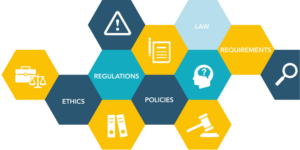
We are thrilled to present the following article by the esteemed Judge Bernice Donald and Ronald Hedges.
Judge Bernice B. Donald is a United States Circuit Judge of the United States Court of Appeals for the Sixth Circuit. She was appointed by President Barack Obama and confirmed by the Senate in 2011. She previously served for 15 years as a United States District Judge of the United States District Court for the Western District of Tennessee.
Ronald J. Hedges, J.D. is a Senior Counsel with Dentons US LLP. He served as a United States magistrate judge in the District of New Jersey for 21 years.
Acknowledgements: We would also like to extend a special thanks to Michael Brody, Judicial Law Clerk to the Hon. Bernice B. Donald, U.S. Court of Appeals for the Sixth Circuit for his assistance with this article.
Introduction
Tele-working has become the norm for many business and government entities, which has resulted in a substantial increase in the volumes and varieties of electronically stored information (“ESI”) than prior to the pandemic.
Take, for example, the following hypothetical discovery request in an employment discrimination case: “Defendant company shall produce all files pertaining to plaintiff-employee’s tenure at company.” In 1990, this request might have yielded little more than a few printed documents stored away in a manilla envelope—easily retrievable and directly on point. Fast forward 31 years: The scope of that request likely encompasses a far broader range of ESI—ranging from emails, online work-product, Zoom video recordings, and other cloud-based items.
Amendments to the Federal Rules of Civil Procedure have contemplated the potential for abuse in discovery, and Rule 26(b)(1) was amended in 2015 to emphasize “proportional” discovery. Amendments in 2006 as well as 2015 provide a number of limitations to discovery of ESI. This blog focuses on Rule 26(b)(2)(B).
Text and History of Rule 26(b)(2)(B)
Rule 26(b)(2)(b) addresses discovery of ESI in terms of sources. The rule has three components—1) appropriate grounds for objection, 2) allocation of burden of proof, and 3) cost-sharing or shifting. The text of the rule is as follows:
A party need not provide discovery of electronically stored information from sources that the party identifies as not reasonably accessible because of undue burden or cost. On motion to compel discovery or for a protective order, the party from whom discovery is sought must show that the information is not reasonably accessible because of undue burden or cost. If that showing is made, the court may nonetheless order discovery from such sources if the requesting party shows good cause, considering the limitations of Rule 26(b)(2)(C). The court may specify conditions for the discovery.
Rule 26(b)(2)(B) made inaccessible ESI presumptively undiscoverable, shifting the burden to the requesting party to make a showing of “good cause.” This effectively establishes a two-tiered framework for courts and litigants. The first is whether the data sought in a discovery request is on a reasonably accessible source.
The Rules do not provide a precise definition of what a “source” is—much less how to define whether it is reasonably accessible. See generally Rule 26. Perhaps that is no surprise, given that the Advisory Committee has been reluctant to even provide a concise definition for ESI. See Rule 34 Advisory Committee Notes (2015) (“The wide variety of computer systems currently in use, and the rapidity of technological change, counsel against a limiting or precise definition of electronically stored information.”). The Advisory Committee noted, however, that different sources of production can take different “forms” that are not simply limited to tangible documents.
Moreover, the Sedona Conference—a research and educational institute dedicated to the advanced study of litigation—has provided guidance as to what is “not reasonably accessible”—or, “NRA”. For example, the Sedona Conference has concluded that the following might be NRA: 1) information on databases whose retrieval cannot be quickly accomplished because the database software is not capable of extracting the information sought without substantial additional programming, 2) information stored on media that must be transformed into another form before search and retrieval can be achieved, 3) deleted information whose fragments remain only accessible by forensics, and 4) legacy data remaining from obsolete systems that is unintelligible on successor systems. See The Sedona Conference Commentary on Preservation, Management and Identification of Sources of Information that are Not Reasonably Accessible.
“Reasonable accessibility” is the crux of a Rule 26(b)(2)(B) motion.
If ESI is reasonably accessible, then the receiving party must produce it. However, if the responding party can demonstrate that the data is not reasonably accessible from the source, then the requesting party must make its “good cause” showing in order to prompt a court to compel discovery.
The Advisory Committee Note to the new Rule 26(b)(2)(B) set out seven factors to be considered to determine whether “good cause” exists. These are:
(1) the specificity of the discovery request;
(2) the quantity of information available from other and more easily accessed sources;
(3) the failure to produce relevant information that seems likely to have existed but is no longer available on more easily accessed sources;
(4) the likelihood of finding relevant, responsive information that cannot be obtained from other, more easily accessed sources;
(5) predictions as to the importance and usefulness of the further information; (6) the importance of the issues at stake in the litigation; and
(7) the parties’ resources.
Despite this guidance, there have been ambiguous applications of Rule 26(b)(2)(B)’s application. As the Advisory Committee noted, “[i]t is not possible to define in a rule the different types of technological features that may affect the burdens and costs of accessing electronically stored information.”).
Case Law Addressing Rule 26(b)(2)(B)
“Reasonable accessibility” is the crux of a Rule 26(b)(2)(B) motion. If the party receiving a discovery request can reasonably access the ESI sought from the sources on which it resides, then compliance will almost certainly be enforced. However, some thornier issues come into play when the receiving party would have to undergo enormous cost and burden in order to access the ESI. “[D]ecisions subsequent to the enactment of Rule 26(b)(2)(B) address accessibility by analyzing the interplay between any alleged technological impediment and the resulting cost and burden.” Chen-Oster v. Goldman, Sachs & Co., 285 F.R.D. 294, 301–02 (S.D.N.Y. 2012).
A court should not be expected to grant a Rule 26(b)(2)(B) motion simply because the producing party may incur significant costs in collecting the information—or by paying a third-party (typically, a forensic examiner) to do it. For example, in Wynmoor Cmty. Council, Inc. v. QBE Ins. Corp., 280 F.R.D. 681 (S.D. Fla. 2012), the court allowed the defendant-insurance company to complete a costly forensic examination of the plaintiffs’—a group of condominium associations—ESI in an action to recover losses following a hurricane.
In so ruling, the court noted that the associations had either been unwilling or unable to conduct a search of their computer systems, the damages sought were substantial, the associations had shredded large numbers of paper documents, and the associations had made no efforts to identify ESI responsive to the company’s discovery requests.
But courts are also mindful of privacy interests. For example, in Hespe v. City of Chicago, 2016 WL 7240754 (N.D. Ill. Dec. 15, 2016), the plaintiff produced 850 text messages in response to discovery requests. The messages produced represented only a small portion of the total relevant texts. After subpoenaing the plaintiff’s mother, the defendants learned that the plaintiff had failed to produce more than 5,700 relevant texts. The court denied the defendants’ request for a forensic exam of the plaintiff’s device to recover the unproduced messages, citing the plaintiff’s privacy interests. In particular, the court explained that, “[t]he evidence of fault is sparse at best” and that the evidence sought did not outweigh the “plaintiff’s interest in protecting her privacy” or justify the defendants having “unfettered access to her personal devices[.]” But see First Niagra Risk Mgt., Inc. v. Folino, 317 F.R.D. 23 (E.D. Pa. 2016) (granting plaintiff-employer’s request to search defendant-former-employee’s electronic devices for texts and emails, where court determined that even “exorbitant discovery requests” did not outweigh “the benefit of discovery for [the company], who [] ha[d] uncovered evidence that one of its top executives may have started a competing company while under its employ.”). These considerations carry into a 26(b)(2)(B) analysis.
In the 2006 Amendments, the Committee identified the following sources of information as likely to be “inaccessible”: magnetic backup tapes, legacy data that is unintelligible, fragmented data after deletion, and unplanned output from databases different from designed uses, and courts have followed the Committee’s lead, finding that backup tapes (General Electric Co. v. Wilkins, 2012 WL 570048 (E.D. Ca. Feb. 1, 2012) and audio files (General Steel Domestic Sales, LLC v. Chumley, 2011 WL 2415715 (D. Colo. June 15, 2011)) as devices that are not “reasonably accessible.”
Yet, businesses and individuals have found rapid and ever-changing ways of managing and storing their information in the last decade-and-a-half. Is a compressed video file 10 years old inaccessible? Surely it could be reproduced, but at what cost (both money and manpower), and what is the likelihood that it could be restored in full?
Similarly, what about the booming use of webinar applications in the wake of the ongoing pandemic? Are Zoom, GoToWebinar, Microsoft Teams, among others, potentially per se NRA? Take Slack, for example. The existing data on Slack might be reasonably accessible but the implementation of it will greatly affect the amount of unique information, and the accessibility of such information. Such systems may for example track edits and deletions instead of actually deleting the data in some versions, and in other versions may delete data and not track the changes or deletions at all.
Preservation functionality must also be top of mind, as a lack of preservation in place functionality might force a business into a costly discovery battle. Often enterprises find themselves needing to pay for additional systems to handle collection to preserve in a coherent manner, and to just stitch the data back into readable and searchable conversations. This amounts to additional costs, additional expertise, and additional burden.
That is where cost-shifting or sharing come into play.
Cost-Shifting or Sharing
If a court determines that ESI is not reasonably accessible, it is not necessarily game over for the requesting party. That is, of course, if the requesting party can demonstrate—with a showing of “good cause”—that the benefits of discovery outweigh the potential costs. With a test like that, there is no magic formula, but courts will consider a variety of considerations—as mentioned above.
Courts seem to employ a sliding-scale in their approach. The more relevant the sought-after-ESI, the more likely the court is to shift costs to the requesting party. See Rule 26(c)(1)(B) (“The court may, for good cause, issue an order to protect a party or person from annoyance, embarrassment, oppression, or undue burden or expense, including … specifying terms, including time and place or the allocation of expenses, for the disclosure or discovery[.]”).
But for issues that are less relevant, the receiving party is likely to still bear expense even for more burdensome requests.
For example, in Annex v. City of Indianapolis, 2012 WL 892170, at *4 (S.D. Ind. Mar. 14, 2012), an Indiana federal court granted the City of Indianapolis’ motion to compel bookkeeping records from the plaintiffs. The plaintiffs provided the city with data on four discs that turned out to be unreadable. Attempts to restore the data with the help of forensic computer experts failed. The plaintiffs—invoking Rule 26(b)(2)(B)—informed the court that any subsequent attempts to retrieve the data would be unduly burdensome.
As a result, the court made its order conditional. Specifically, the court concluded that, even though critical information was likely contained within the bookkeeping records, the plaintiff had made good faith efforts to restore the data. The court held that, if the city wanted the data restored, it could continue to make that pursuit but, “[it] must bear the future costs of continuing down this road.”
Courts are also willing to strike unique compromises between the parties so that cost-shifting is narrowly tailored. In Solo v. United Parcel Serv. Co., 2017 WL 85832 (E.D. Mich. Jan. 10, 2017), the plaintiffs were pursuing a class-action against UPS for breaching its contract with shippers for shipments over $300. Although the plaintiffs alleged that the conduct in question dated back as far as 2008, legal parameters related to arbitration and filing limitations made it most likely that the most relevant time frame was from June 30, 2013 to December 29, 2013. Further, because UPS had indicated that it would be burdensome to retrieve all the ESI just for that time frame, the court permitted it to produce a “sampling of records,” leaving it to the parties to work out a methodology to retrieve the data. The court agreed to shift the costs to the plaintiffs in the event that the parties could not agree on a methodology, with the plaintiffs “bearing the entire cost of production.”; See Connecticut General Life Ins. Co. v. Earl Scheib, Inc., 2013 WL 485846, at *3 (S.D. Cal. 2013) (explaining that “shifting the cost of production … should be considered only when data is sought from an inaccessible format”); Elkharwily v. Franciscan Health System, 2016 WL 4061575, at *3 (W.D. Wash. 2016) (“Although Plaintiff has not met his burden to show good cause, which would overcome Defendant’s showing that producing the archived emails is costly and burdensome, the archived emails are ‘discoverable’ under Fed. R. Civ. P. 26(b)(1). Therefore, upon a request by Plaintiff, Defendant should facilitate access to the discovery, but should do so only at Plaintiff’s expense, payable in advance.”).
Courts are not always generous to the requesting party. For example, in Kang v. Credit Bureau Connection, Inc., 2020 WL 1689709 (E.D. Cal. Apr. 7, 2020), a California federal court refused to shift costs to the defendant-consumer credit corporation, despite the corporation’s claim that the information sought by the plaintiffs was stored in an encrypted databased with “no searchable capability.” In order to retrieve the data, the company stated that it would have to write two software programs to manually review individual transactions.
However, the court determined that the company’s $3 million cost-estimate was based on an unsupported assumption about the excessive number of files that would be subject to review. The court held that “even if some portion of [the company’s] representations about the processes described is supportable, the fact that there are numerous files, or [the company] has stored them in an unorganized fashion, does not excuse their production.” 2020 WL 1689708, at *6. Further, the court found that the “[p]laintiff’s discovery requests [were] specific … and the information will be useful—and in fact is essential—to [the p]laintiff’s class certification motion.”
In Conclusion
The 2015 Amendments to Rule 26 are likely to encourage parties to seek more cost-shifting or sharing in discovery, despite the Advisory Committee’s note that motions for cost allocation are not to become a “common practice.” But cost allocation between the parties might be the most equitable way of addressing expensive discovery in the context of rapidly evolving technology, as courts try to define the contours of a “reasonably accessible source.”




